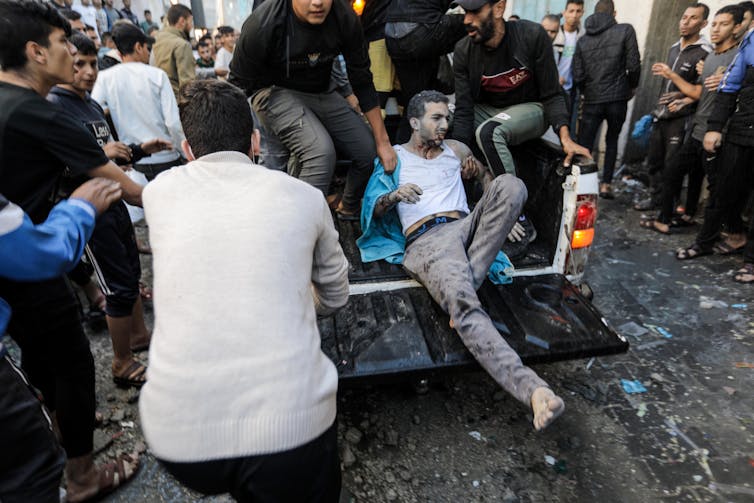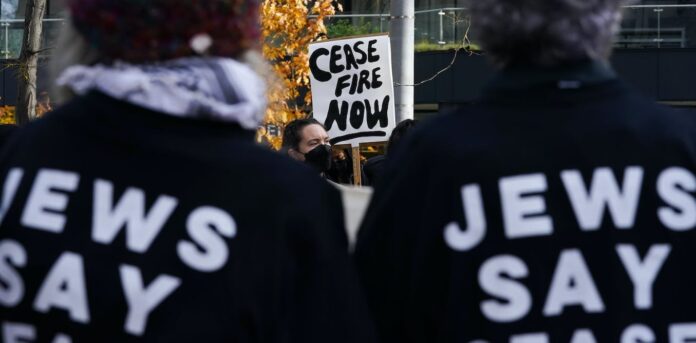What would it take for a cease-fire to happen in Gaza?
By Laurie Nathan, University of Notre Dame
Calls for a cease-fire and other limits on military operations and violence were made by governments, advocacy groups and political leaders around the world almost immediately after the Oct. 7, 2023, massacre of 1,200 Israeli civilians by Hamas. Israel immediately declared war on Hamas and began shelling and then invaded Gaza, leading to more than 11,000 civilian deaths and massive destruction.
Global calls for cease-fires have continued to be made by hundreds of disparate organizations and tens of thousands of demonstrators.
The United Nations General Assembly and Security Council have issued calls for fighting to stop, to ensure “the immediate, continuous, sufficient and unhindered provision of essential goods and services to civilians throughout the Gaza Strip” and to ensure “immediate, full, sustained, safe and unhindered humanitarian access” for the U.N. and other agencies.
To date, there has been no cease-fire, though in early November, Israel agreed to stop attacks for four hours a day to allow refugees to flee and aid to be distributed. And other efforts to establish a cease-fire agreement are reportedly underway.
Those demanding a cease-fire are driven by humanitarian compassion and principles, primarily the need to protect civilians caught up in a terrible war. But as a scholar of mediation who also works as an international mediator, I know that cease-fires are technically complicated military and political undertakings that always entail risk and require specialist expertise.
The basic requirements
In addition to providing mediation training to senior international diplomats, I have done comparative research on what constitutes a strong cease-fire. I also have practical experience: In 2005 and 2006 I was a member of the African Union mediation team for ending violent conflict in Darfur, responsible for drafting the peace agreement’s cease-fire provisions. To this end, I facilitated tense negotiations between Sudanese military officers and Darfur rebels.
On the basis of my research and experience, it is clear that a strong cease-fire agreement must always have clear and viable rules and timelines, including about the use and control of weapons, the movements of fighters and the activities of humanitarian agencies.
The leadership and rank and file of the opposing forces must understand precisely what their responsibilities are in a cease-fire. They must know exactly what activities are prohibited and what activities are permitted.
Moreover, the rules and procedures must be tailored to the particular political, military and geographic circumstances of each conflict. The details of a humanitarian cease-fire agreement for Gaza would look completely different from, say, the cease-fire agreement for Darfur. And it needs political will from the opposing parties, which varies from case to case and can change over time.
A cease-fire for Gaza
The relevant circumstances of Gaza include these facts:
- Israel has much more powerful military capabilities than Hamas.
- The fighting in Gaza is taking place in a densely populated area.
- Hamas fighters are physically close to and perhaps even immersed in the civilian population of Gaza.
- The U.N. and numerous other organizations have said it is essential for Hamas to release the Israeli hostages it holds.
- The people of Gaza have critical humanitarian needs for food, water, shelter and safety, as well as hospital and medical support.
The Israeli government and Hamas would have to negotiate mutually acceptable ways of addressing these challenges.
It would also be important to consult the U.N. and other humanitarian agencies to determine what they need in order to provide humanitarian support and protect children, injured people and other vulnerable groups.

The role of trust – and mistrust
Opposing groups who are in violent conflicts inevitably hate and mistrust each other. It is therefore helpful for cease-fire negotiations to be supported by a mediator who is sufficiently trusted by the parties. The mediator can facilitate these negotiations through indirect dialogue – referred to as “shuttle diplomacy” – when the parties are unwilling or unable to meet face-to-face.
In the Gaza crisis, Qatar, supported by the United States, is playing the mediator role. Qatari mediators are attempting to negotiate a deal between Hamas and Israel that could include the release of roughly 50 civilian hostages from Gaza in exchange for a three-day cease-fire.
There are two other ways cease-fires can be strengthened in order to mitigate the hatred and mistrust between the parties. The first is by deploying cease-fire monitors – independent observers on the field of battle – who investigate alleged cease-fire violations. Their presence can help to deter violations.
The second way is by setting up communication channels between the mediator and representatives of the warring parties to resolve disputes and address violations that inevitably arise. The goal is to prevent small-scale violations from escalating into large-scale violations that could herald a return to hostilities.
Political will is important
Israel and Hamas can overcome the technical difficulties of a Gaza cease-fire if they have the political will to do so. It is relevant that Israel and Hamas have previously negotiated cease-fires and truces in Gaza. And in 2023 a truce between Israel and the Gaza-based Islamic Jihad militant group was brokered by Egyptian mediators after cross-border attacks. A cease-fire brokered by the U.S. in November 2012 lasted 18 months. But none of the cease-fires was likely to hold in the long term because they were not linked to a political resolution of the Israel-Palestine conflict.
In responding to the Gaza crisis, some world leaders have appeared confused about the distinction between a truce, a humanitarian pause, a cease-fire and a cessation of hostilities. In general, there is no international consensus on the meaning of these terms. In Gaza, as in every case, the cease-fire objectives, rules and procedures matter more than the labels that are used.
The current focus of international calls for a cease-fire is on humanitarian relief as a short-term objective. But the humanitarian situation, and the need to protect civilians in Gaza, will remain critical in the medium to long term.
The question of a permanent cease-fire and long-term security arrangement will have to be part of any negotiations to finally resolve the Israeli-Palestinian conflict. If the vision of a two-state solution is realized, the challenge will be to ensure that both Israel and an independent Palestinian state can enjoy sovereignty and adequate self-defense without threatening each other.![]()
Laurie Nathan, Professor of the Practice of Mediation, University of Notre Dame
This article is republished from The Conversation under a Creative Commons license. Read the original article.



